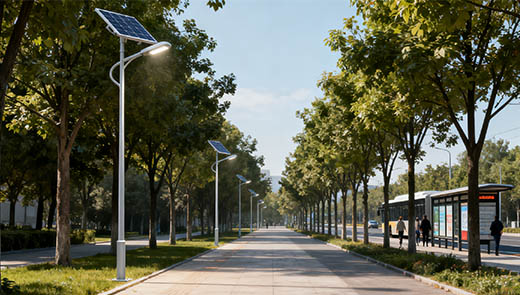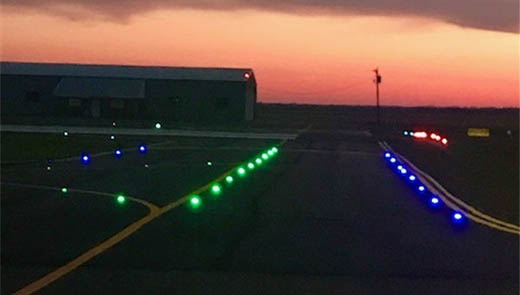Do Solar Lights Work in Winter? Top Tips for Cold Weather
The arrival of winter has caused many people to question the use of solar lights: can solar lights really work properly in winter? Winter poses three major challenges for solar lighting: shorter daylight hours, less light, and lower temperatures. However, advances in solar technology have targeted these issues, allowing solar lights to work in winter.
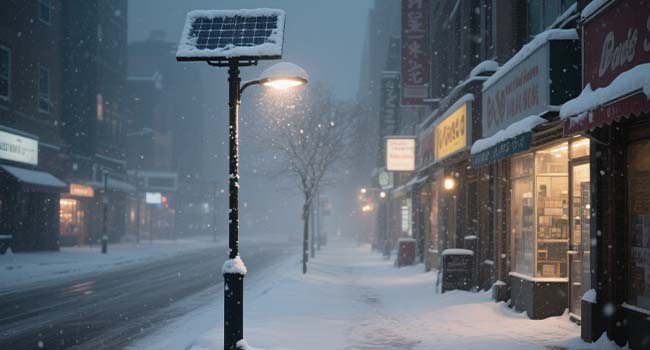
Do solar lights work in winter?
The basic principle of operation
Solar lights work like hybrid cars in that, when conditions are right, the solar panels they are equipped with absorb sunlight and convert the light energy into electricity, which is subsequently stored in a battery for use by the lamps when needed. Even in the winter when the light time is short and the intensity is weak, the well-designed solar lamps can still effectively collect and store energy to meet the basic lighting needs and operate normally with their high-efficiency battery panels and energy storage technology.
Supported by advanced solar technology
Modern photovoltaic technology has made tremendous progress in recent years. Independent efficiency studies have shown that high-efficiency solar panels can maintain up to 50 percent of their charging capacity even on cloudy winter days. Dual panel technology further enhances this ability by better capturing light during the winter months when the sun's position is low. Improvements in materials science and panel design have also increased solar efficiency. Modern panels utilize an improved silicon crystal structure that captures a wider range of light energy. Multi-layer coating technology reduces surface reflections, allowing more photons to enter the energy conversion layer below.
Battery performance in cold weather
Winter temperatures have a specific effect on battery performance. Recent research published in the Journal of Power Sources (2023) shows that lithium-ion batteries retain about 80 percent of their capacity at 0°C, dropping to 55-60 percent at -20°C. New electrolyte compositions can improve low-temperature performance by 15-20%.
Solar light performance in winter
Runtime
Battery performance in winter follows a seasonal pattern. Lighting hours are much shorter in winter than in other seasons, which directly leads to a significant reduction in the charging time of solar lights. At the same time, the energy consumption of the lamps themselves will increase under low temperature, and the double effect usually reduces the running time of solar lamps. According to records, high quality lithium batteries can withstand about 600 charging cycles, even so, the actual running time will still vary depending on the local sunshine duration (e.g. winter sunshine in the north is significantly shorter than that in the south), weather conditions (sunny days and cloudy days are very different), and the characteristics of the system (different brands and models have different energy storage and energy saving capabilities).
System life
Cold weather affects system components differently. LED components are highly stable and usually operate efficiently over their rated life of 50,000 hours or more, whether in hot summers or cold winters, with minimal seasonal effects. However, environmental conditions can have a significant impact on the life of the entire system, especially the battery. Prolonged exposure to extremely low temperatures below - 20°C slows down the internal chemistry of the battery and may accelerate battery deterioration. However, sound thermal management and charge control systems can help to mitigate the negative effects of such low temperatures by effectively regulating the battery's operating environment.
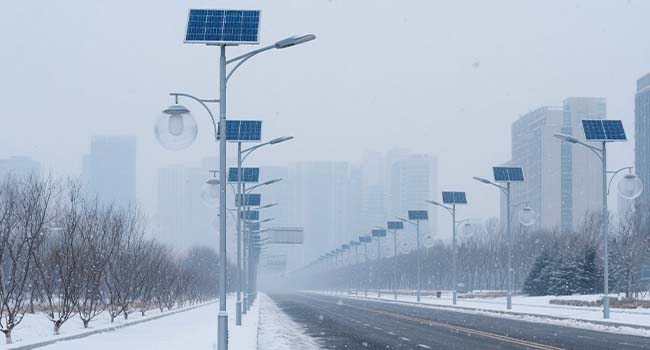
Key parameters for guaranteeing winter performance
Certain technical parameters are critical when it comes to winter performance, and they form the basis for the stable operation of a solar light during the winter months. Any outdoor solar lighting system should have a waterproof rating of IP65 and above, which prevents water from melting snow and ice from penetrating the device and damaging the circuitry.
The operating temperature range must extend to at least -20°C in order to cope with the low winter temperatures found in most regions and ensure that the equipment does not go on strike due to low temperatures. Battery capacity is recommended to be at least 2,000mAh for residential applications to meet the basic lighting needs of the home, and at least 5,000mAh for commercial installations to support a wider range of lighting for longer periods of time. The panel conversion efficiency should never be lower than 15%, which is the basic requirement to ensure charging effect under the weak light in winter.
Winter charging tips for solar lights
How do solar lights charge in the winter?
Modern solar lights use high-efficiency panels that have been optimized for the winter environment and have a much higher efficiency of light conversion, so that they can generate enough electricity to meet basic lighting needs in the winter with only 4-5 hours of sunlight. Many solar lights are also equipped with a dual-phase system, which allows the light to be used for a variety of purposes. Many solar lights also feature bispectral technology, which captures both visible and infrared photons, making the most of the limited light sources available during the winter months and dramatically improving charging even in low-light environments, such as early mornings and late evenings.
Do solar lights charge on cloudy days?
Can. The new solar panels utilize advanced concentrating technology to harvest energy from scattered light in the air and light reflected from objects. Even on cloudy days, when the sun is blocked by clouds, the available light can be absorbed and converted into electricity for storage. Under cloudy conditions, advanced models equipped with enhanced photocells can charge up to 25% more efficiently than regular models, guaranteeing a certain level of energy storage.
Do solar lights require direct sunlight?
Direct sunlight allows solar lights to achieve the highest charging efficiency because it is when the light is strongest and the energy is most concentrated. But the new solar lights no longer rely on direct sunlight. Their panels are designed with a wider range of light exposure and a high-sensitivity photocell that captures a variety of light sources, including indirect light reflecting off buildings or the ground, as well as ambient light, to maintain a certain level of charging capacity even in cooler areas.
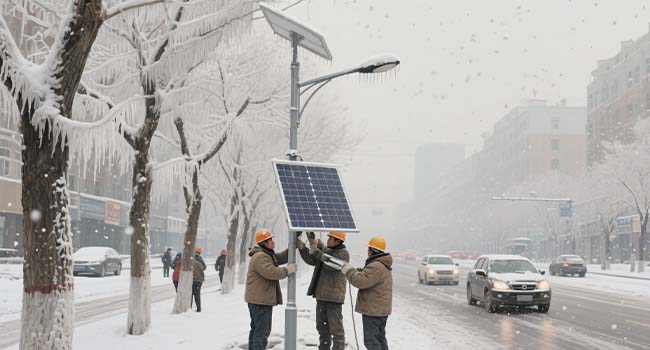
Top tips for using solar lights in cold weather
Installation strategies
Strategic angling of solar panels is key to safeguarding their effectiveness in winter. The panels can be tilted at an angle of 30°-45° (or more in northern regions), depending on the local winter sun angle. This angle not only allows the sun to hit the panels at a more vertical angle, which improves the efficiency of light absorption, but it also allows for effective snow removal by gravity - any snow that falls on the panels will naturally slide off the tilted surface, preventing it from accumulating and blocking the light. Even if there is a small amount of residual snow, the heat generated by sunlight quickly melts it, ensuring that the panels remain clean and functional, and that they are continuously exposed to sunlight for optimal energy generation, providing stable power for winter lighting.
Winter maintenance essentials
Regularly remove snow and ice from solar panels and luminaires. Use a soft brush to clean to avoid scratching the surface. Check for ice damage to the luminaire or wiring. Watch out for cracks or breaks caused by low temperatures. Verify that the battery compartment seal is tight to prevent moisture from entering. Keeping battery panels clean improves efficiency, and is especially important during the shorter days of winter. In addition, keep a close eye on overall performance and address any problems if you notice them. Reliable lighting is essential for safety, especially in locations such as smart bus stops.
Battery and wiring checks
Before winter sets in, test battery capacity and charge cycles. Check for any performance degradation. Check wiring for wear and tear or damage due to summer heat, and look for frayed or exposed wires. Deal with problems immediately to prevent malfunctions. Clean battery terminals to avoid corrosion. Proper maintenance keeps the system in good condition. Make sure the battery compartment is sealed against moisture. Regular inspection and timely replacement can ensure reliable operation in cold weather. These tasks are important in the seasonal maintenance checklist for solar street lights.
Common winter challenges and solutions
Performance optimization
Temperature changes have a great impact on system performance, especially in winter when the temperature difference between daytime and nighttime is large, which easily leads to fluctuations in battery charging and discharging efficiency. The temperature compensation technology used in professional-grade systems can monitor changes in ambient temperature in real time and automatically adjust parameters such as charging voltage and current. For example, when the temperature is low, the charging voltage can be increased appropriately to ensure that the battery can fully store energy. This adaptive technology ensures stable performance in different winter environments.
Selecting the right system
Selecting the right solar lighting system requires a thorough analysis of the specific application scenario. Commercial locations such as parking lots and sidewalks require industrial-grade systems with professional monitoring and control features. These systems should have a minimum lifespan of 10 years and be equipped with backup power for critical applications. For home applications, choose systems that are easy to maintain and have smart charging capabilities. Integrated motion sensors can significantly extend battery life by adjusting power consumption to actual lighting needs.
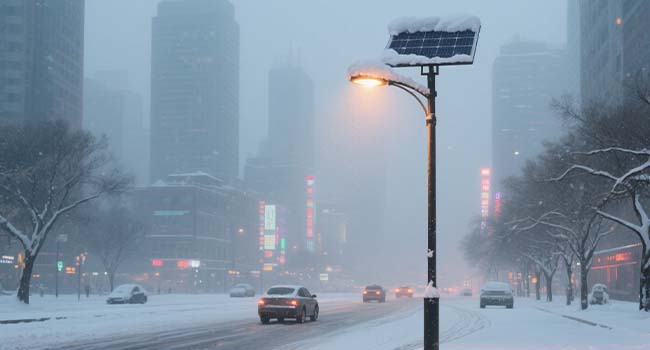
Technology innovations
Solar lighting is a rapidly growing industry. Recent advances include self-cleaning panel surfaces and improved cold-resistant battery chemistry. Artificial intelligence-driven management solutions now automatically adjust system parameters based on weather forecasts, providing predictive maintenance.
Cost considerations
The initial investment in a professional-grade solar lighting system is relatively high, but it is highly reliable over the long term. With regular maintenance, they can last 10 years or more. Because of their high reliability and low maintenance requirements, these systems typically provide better long-term value. Consumer-grade solar lighting systems, on the other hand, have a lower initial investment, although their long-term reliability is relatively low. Under regular maintenance conditions, the service life is typically only 2-3 years.
Solar lights can be used properly in winter with advanced technology. To get the best performance out of solar lights in winter, it is crucial to choose the right system, do the right installation and do regular maintenance. By doing these things right, you can take full advantage of solar lights in the winter.


